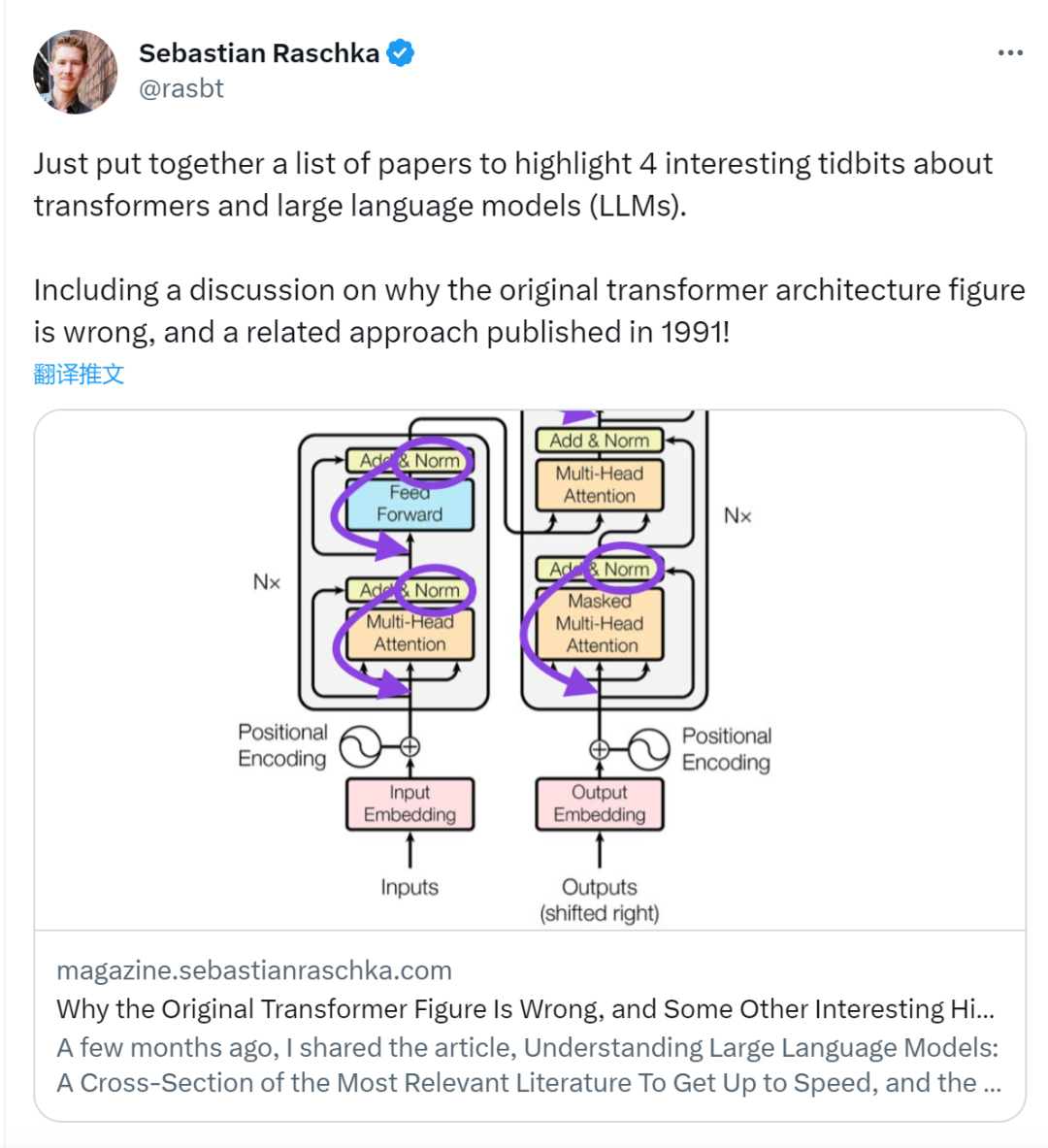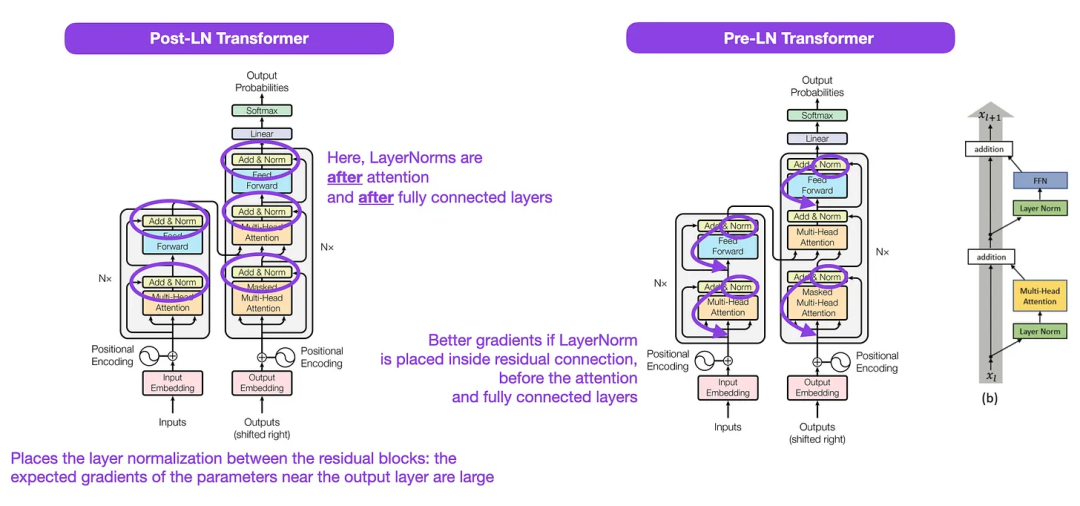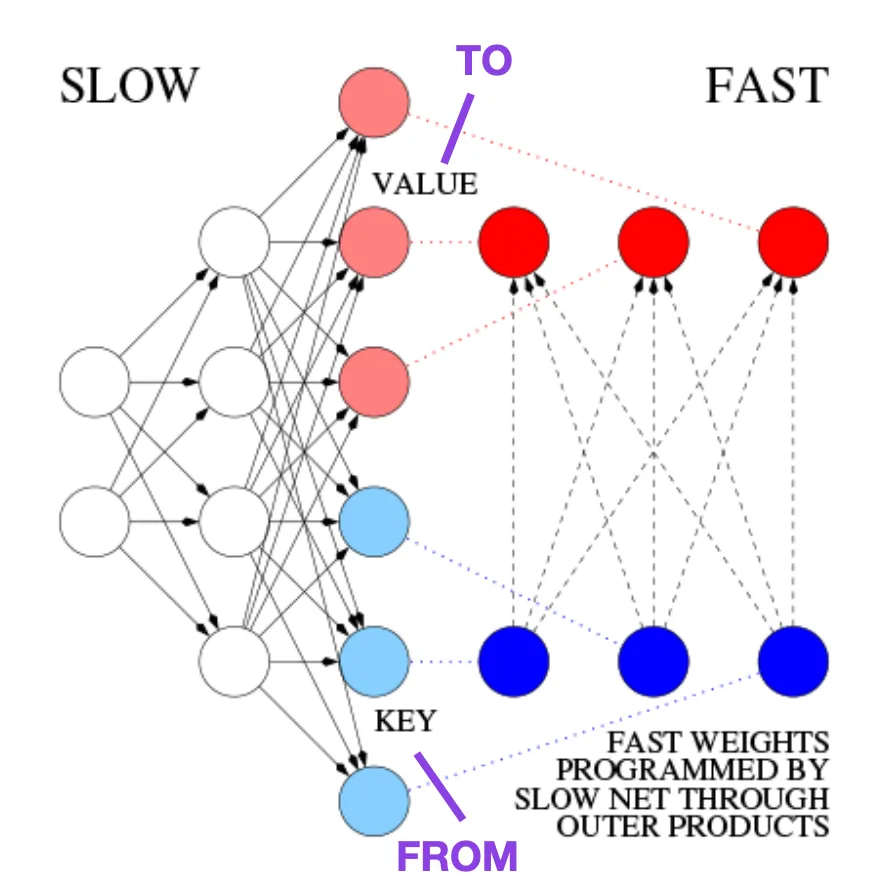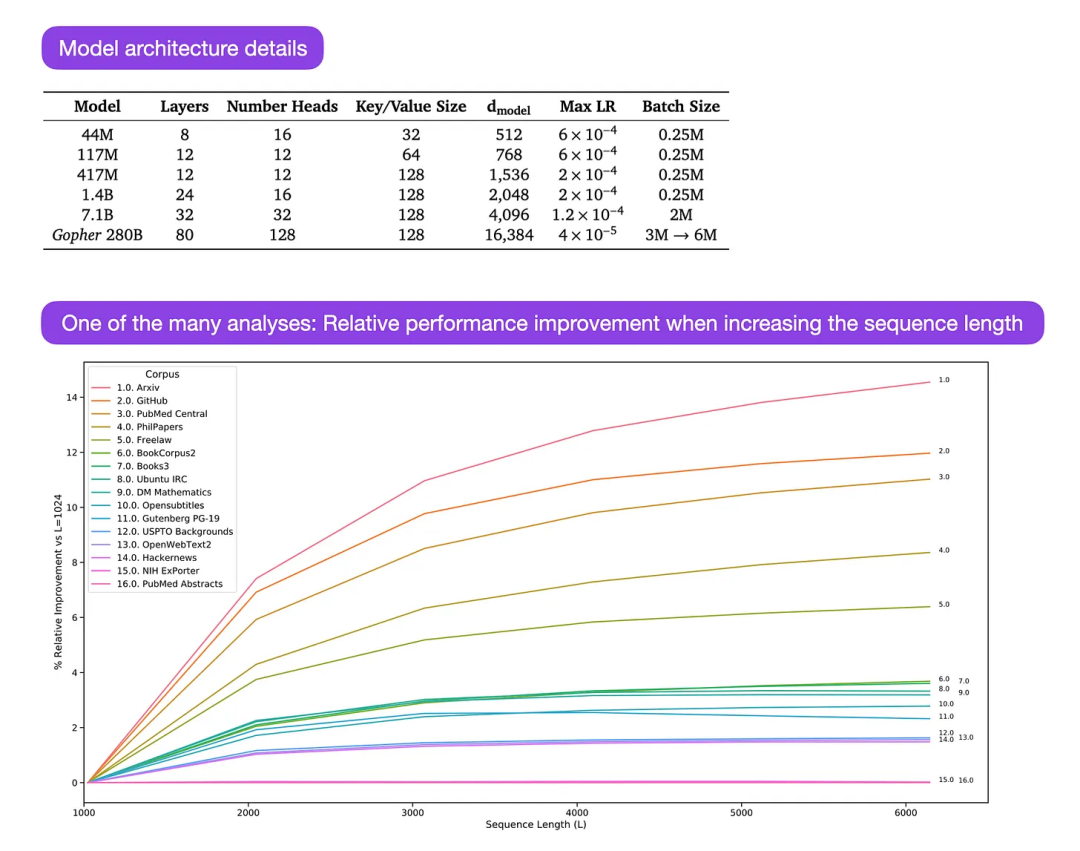 Technology peripherals
Technology peripherals
 AI
AI
 This 'mistake' is not really a mistake: start with four classic papers to understand what is 'wrong' with the Transformer architecture diagram
This 'mistake' is not really a mistake: start with four classic papers to understand what is 'wrong' with the Transformer architecture diagram
This 'mistake' is not really a mistake: start with four classic papers to understand what is 'wrong' with the Transformer architecture diagram
Some time ago, a tweet pointing out the inconsistency between the Transformer architecture diagram and the code in the Google Brain team's paper "Attention Is All You Need" triggered a lot of discussion.
Some people think that Sebastian’s discovery was an unintentional mistake, but at the same time it is also strange. After all, given the popularity of the Transformer paper, this inconsistency should have been mentioned a thousand times over.
Sebastian Raschka said in response to netizen comments that the "most original" code is indeed consistent with the architecture diagram, but the code version submitted in 2017 was modified, but the architecture was not updated at the same time. picture. This is also the root cause of "inconsistent" discussions.
Subsequently, Sebastian published an article on Ahead of AI specifically describing why the original Transformer architecture diagram was inconsistent with the code, and cited multiple papers to briefly explain the development and changes of Transformer.

##The following is the original text of the article, let us take a look at what the article is about:
A few months ago I shared Understanding Large Language Models: A Cross-Section of the Most Relevant Literature To Get Up to Speed and the positive feedback was very encouraging! Therefore, I've added a few papers to keep the list fresh and relevant.
At the same time, it is crucial to keep the list concise and concise so that everyone can get up to speed in a reasonable amount of time. There are also some papers that contain a lot of information and should probably be included.
I would like to share four useful papers to understand Transformer from a historical perspective. While I'm just adding them directly to the Understanding Large Language Models article, I'm also sharing them separately in this article so that they can be more easily found by those who have read Understanding Large Language Models before.
On Layer Normalization in the Transformer Architecture (2020)
Although the original image of Transformer in the picture below (left) (https://arxiv.org/abs/1706.03762) is a useful summary of the original encoder-decoder architecture, but there is a small difference in the diagram. For example, it does layer normalization between residual blocks, which does not match the official (updated) code implementation included with the original Transformer paper. The variant shown below (middle) is called the Post-LN Transformer.
The layer normalization in the Transformer architecture paper shows that Pre-LN works better and can solve the gradient problem as shown below. Many architectures adopt this approach in practice, but it can lead to a breakdown in representation.
So, while there is still discussion about using Post-LN or Pre-LN, there is also a new paper that proposes applying both together: "ResiDual: Transformer with Dual Residual" Connections" (https://arxiv.org/abs/2304.14802), but whether it will be useful in practice remains to be seen.

Illustration: Source https://arxiv.org/abs/1706.03762 ( Left & Center) and https://arxiv.org/abs/2002.04745 (Right)
##Learning to Control Fast-Weight Memories: An Alternative to Dynamic Recurrent Neural Networks (1991)
This article is recommended for those interested in historical tidbits and early methods that are basically similar to the modern Transformer.For example, in 1991, 25 years before the Transformer paper, Juergen Schmidhuber proposed an alternative to recurrent neural networks (https://www.semanticscholar.org/paper/Learning-to-Control- Fast-Weight-Memories:-An-to-Schmidhuber/bc22e87a26d020215afe91c751e5bdaddd8e4922), called Fast Weight Programmers (FWP). Another neural network that achieves fast weight changes is the feedforward neural network involved in the FWP method that learns slowly using the gradient descent algorithm. This blog (https://people.idsia.ch//~juergen/fast-weight-programmer-1991-transformer.html#sec2) compares it with a modern Transformer The analogy is as follows: In today's Transformer terminology, FROM and TO are called key and value respectively. The input to which the fast network is applied is called a query. Essentially, queries are handled by a fast weight matrix, which is the sum of the outer products of keys and values (ignoring normalization and projection). We can use additive outer products or second-order tensor products to achieve end-to-end differentiable active control of rapid changes in weights because all operations of both networks support differentiation. During sequence processing, gradient descent can be used to quickly adapt fast networks to the problems of slow networks. This is mathematically equivalent to (except for the normalization) what has come to be known as a Transformer with linearized self-attention (or linear Transformer). As mentioned in the excerpt above, this approach is now known as linear Transformer or Transformer with linearized self-attention. They come from the papers "Transformers are RNNs: Fast Autoregressive Transformers with Linear Attention" (https://arxiv.org/abs/2006.16236) and "Rethinking Attention with Performers" (https://arxiv. org/abs/2009.14794). In 2021, the paper "Linear Transformers Are Secretly Fast Weight Programmers" (https://arxiv.org/abs/2102.11174) clearly shows that linearized self-attention and the 1990s Equivalence between fast weight programmers. ##Photo source: https://people.idsia.ch// ~juergen/fast-weight-programmer-1991-transformer.html#sec2 ##Universal Language Model Fine-tuning for Text Classification (2018) ULMFit’s proposed language model fine-tuning process is divided into three stages:
However, as a key part of ULMFiT, progressive unfreezing is usually not performed in practice because Transformer architecture usually fine-tunes all layers at once.
Gopher is a particularly good paper (https://arxiv.org/abs/2112.11446) that includes extensive analysis to understand LLM training. The researchers trained an 80-layer, 280 billion parameter model on 300 billion tokens. This includes some interesting architectural modifications, such as using RMSNorm (root mean square normalization) instead of LayerNorm (layer normalization). Both LayerNorm and RMSNorm are better than BatchNorm because they are not limited to batch size and do not require synchronization, which is an advantage in distributed settings with smaller batch sizes. RMSNorm is generally considered to stabilize training in deeper architectures. Besides the interesting tidbits above, the main focus of this article is to analyze task performance analysis at different scales. An evaluation on 152 different tasks shows that increasing model size is most beneficial for tasks such as comprehension, fact-checking, and identifying toxic language, while architecture expansion is less beneficial for tasks related to logical and mathematical reasoning. ##Illustration: Source https://arxiv.org/abs/2112.11446
1. Training the language on a large text corpus Model;
This method of training a language model on a large corpus and then fine-tuning it on downstream tasks is based on Transformer models and basic models (such as BERT, GPT -2/3/4, RoBERTa, etc.). 
The above is the detailed content of This 'mistake' is not really a mistake: start with four classic papers to understand what is 'wrong' with the Transformer architecture diagram. For more information, please follow other related articles on the PHP Chinese website!

Hot AI Tools

Undresser.AI Undress
AI-powered app for creating realistic nude photos

AI Clothes Remover
Online AI tool for removing clothes from photos.

Undress AI Tool
Undress images for free

Clothoff.io
AI clothes remover

AI Hentai Generator
Generate AI Hentai for free.

Hot Article

Hot Tools

Notepad++7.3.1
Easy-to-use and free code editor

SublimeText3 Chinese version
Chinese version, very easy to use

Zend Studio 13.0.1
Powerful PHP integrated development environment

Dreamweaver CS6
Visual web development tools

SublimeText3 Mac version
God-level code editing software (SublimeText3)

Hot Topics
 1359
1359
 52
52
 How to change the size of a Bootstrap list?
Apr 07, 2025 am 10:45 AM
How to change the size of a Bootstrap list?
Apr 07, 2025 am 10:45 AM
The size of a Bootstrap list depends on the size of the container that contains the list, not the list itself. Using Bootstrap's grid system or Flexbox can control the size of the container, thereby indirectly resizing the list items.
 How to implement nesting of Bootstrap lists?
Apr 07, 2025 am 10:27 AM
How to implement nesting of Bootstrap lists?
Apr 07, 2025 am 10:27 AM
Nested lists in Bootstrap require the use of Bootstrap's grid system to control the style. First, use the outer layer <ul> and <li> to create a list, then wrap the inner layer list in <div class="row> and add <div class="col-md-6"> to the inner layer list to specify that the inner layer list occupies half the width of a row. In this way, the inner list can have the right one
 How to add icons to Bootstrap list?
Apr 07, 2025 am 10:42 AM
How to add icons to Bootstrap list?
Apr 07, 2025 am 10:42 AM
How to add icons to the Bootstrap list: directly stuff the icon into the list item <li>, using the class name provided by the icon library (such as Font Awesome). Use the Bootstrap class to align icons and text (for example, d-flex, justify-content-between, align-items-center). Use the Bootstrap tag component (badge) to display numbers or status. Adjust the icon position (flex-direction: row-reverse;), control the style (CSS style). Common error: The icon does not display (not
 What method is used to convert strings into objects in Vue.js?
Apr 07, 2025 pm 09:39 PM
What method is used to convert strings into objects in Vue.js?
Apr 07, 2025 pm 09:39 PM
When converting strings to objects in Vue.js, JSON.parse() is preferred for standard JSON strings. For non-standard JSON strings, the string can be processed by using regular expressions and reduce methods according to the format or decoded URL-encoded. Select the appropriate method according to the string format and pay attention to security and encoding issues to avoid bugs.
 What changes have been made with the list style of Bootstrap 5?
Apr 07, 2025 am 11:09 AM
What changes have been made with the list style of Bootstrap 5?
Apr 07, 2025 am 11:09 AM
Bootstrap 5 list style changes are mainly due to detail optimization and semantic improvement, including: the default margins of unordered lists are simplified, and the visual effects are cleaner and neat; the list style emphasizes semantics, enhancing accessibility and maintainability.
 How to view Bootstrap's grid system
Apr 07, 2025 am 09:48 AM
How to view Bootstrap's grid system
Apr 07, 2025 am 09:48 AM
Bootstrap's mesh system is a rule for quickly building responsive layouts, consisting of three main classes: container (container), row (row), and col (column). By default, 12-column grids are provided, and the width of each column can be adjusted through auxiliary classes such as col-md-, thereby achieving layout optimization for different screen sizes. By using offset classes and nested meshes, layout flexibility can be extended. When using a grid system, make sure that each element has the correct nesting structure and consider performance optimization to improve page loading speed. Only by in-depth understanding and practice can we master the Bootstrap grid system proficiently.
 Laravel's geospatial: Optimization of interactive maps and large amounts of data
Apr 08, 2025 pm 12:24 PM
Laravel's geospatial: Optimization of interactive maps and large amounts of data
Apr 08, 2025 pm 12:24 PM
Efficiently process 7 million records and create interactive maps with geospatial technology. This article explores how to efficiently process over 7 million records using Laravel and MySQL and convert them into interactive map visualizations. Initial challenge project requirements: Extract valuable insights using 7 million records in MySQL database. Many people first consider programming languages, but ignore the database itself: Can it meet the needs? Is data migration or structural adjustment required? Can MySQL withstand such a large data load? Preliminary analysis: Key filters and properties need to be identified. After analysis, it was found that only a few attributes were related to the solution. We verified the feasibility of the filter and set some restrictions to optimize the search. Map search based on city
 How to center images in containers for Bootstrap
Apr 07, 2025 am 09:12 AM
How to center images in containers for Bootstrap
Apr 07, 2025 am 09:12 AM
Overview: There are many ways to center images using Bootstrap. Basic method: Use the mx-auto class to center horizontally. Use the img-fluid class to adapt to the parent container. Use the d-block class to set the image to a block-level element (vertical centering). Advanced method: Flexbox layout: Use the justify-content-center and align-items-center properties. Grid layout: Use the place-items: center property. Best practice: Avoid unnecessary nesting and styles. Choose the best method for the project. Pay attention to the maintainability of the code and avoid sacrificing code quality to pursue the excitement



